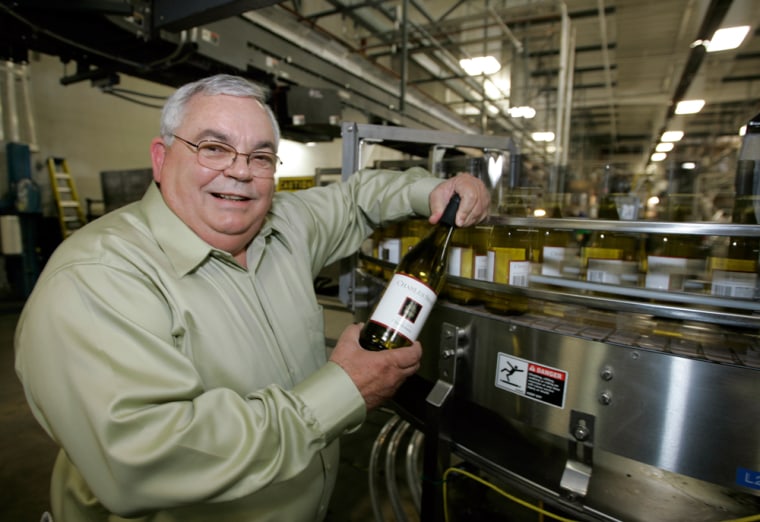Round and round they go, hundreds of bottles of Two Buck Chuck rattling and clinking their way toward a big machine that deftly fills, corks and seals each one in a rhythmic dance of metal and glass.
It’s been five years since the first of these amazingly cheap chardonnays and cut-price cabernets started rolling off the line, released by maverick vintner Fred Franzia under the formal label of Charles Shaw wines.
Three hundred million bottles later, Two Buck Chuck is still selling, and Franzia is still preaching his message of wine for the masses.
“We’re not out to gouge people,” says Franzia. “What I would like to see is every consumer be able to afford to have wine on the table every day and not feel insecure about it.”
Last year, Two Buck Chuck — available only in the Trader Joe’s grocery chain and priced at $1.99 in California, hence its nickname — accounted for at least 8 percent of California wine sold in-state, said Jon Fredrikson, who tracks wine shipments through his Woodland-based company, Fredrikson, Gomberg & Associates. National market share figures are not available.
The result — along with the cute “critter” labels and more user-friendly packaging like boxes and screw caps — has helped knock a little of the starch out of the industry, said the wine industry consultant.
“I think it shook up the business in several ways, but certainly it created this interest among consumers to seek out wine values,” said Fredrikson. “It certainly plants a seed in everyone’s mind about what you get for the money.”

Michael Mondavi, founder of Folio Fine Wine Partners, a Napa Valley-based importer and producer of high-end wines, takes the wine-glass-half-full approach to the Franzia effect.
“I think Two Buck Chuck has helped to make people aware that wine is not just for special occasions,” says Mondavi, son of California wine country pioneer Robert Mondavi and a longtime friend of Franzia’s. “I also believe that the vast majority of the people who originally start buying Two Buck Chuck within a period of a year trade up to better wines and enjoy better wines on a more regular basis.”
Franzia’s roots in the winery business go deep. His grandfather, Giuseppe Franzia, immigrated from Italy to America in 1893, buying land in California in 1912 and beginning wine production three years later.
In 1933, the family started Franzia Brothers Winery, producing 100,000 gallons of table wine that year. After that winery was sold in 1973, Franzia, his brother Joseph and cousin John, started Bronco. (The family has no connection with the boxed wine sold today under the Franzia name.)
Franzia has crossed legal swords with the wine establishment more than once.
More than a decade ago he and the company were fined after he pleaded no-contest to charges of mislabeling some grapes as a more expensive variety. More recently, he was engaged in a pitched court battle with Napa vintners who argued that it was illegal for Bronco to sell wines which have “Napa” in their name but are made with grapes grown elsewhere.
Franzia lost that fight. But he soon had Napa buzzing again when he rereleased one of the disputed brands, Napa Creek — this time made with Napa grapes — and priced it at $3.99.
Making wine is expensive from the ground up, but Franzia owns a lot of ground — 40,000 acres is the common estimate. He won’t say. His Ceres-based Bronco Wine Co. also owns the crushing and bottling plants and has its own distribution company.
Until now, another company has supplied the bottles. But Franzia’s latest idea is to fix that by building a glass container plant near his Napa Valley bottling facility in a business park near the Napa County Airport.
Still in the preliminary planning stages, Franzia says the plant would reduce greenhouse gases by cutting down on delivery driving hours as well as using environmentally friendly technology to cut down on plant emissions.
This spring, he introduced plans for the glass plant by hosting an elegant lunch in Napa — the whitest tablecloths, the finest food, all washed down with your choice of Two Buck Chuck.
Industry veteran Richard Peterson, who worked for decades for E. & J. Gallo and other major California wineries and is now consulting for Bronco, sees Franzia as the guy Napa vintners love to hate.
“I enjoy watching them spar,” he says with a chuckle.
“We do business with many, many people in Napa,” says Franzia. “A lot of my friends are in Napa. Part of the fun is just rubbing their nose in it a little bit and I’m sure vice versa.”
For instance: “He says no wine is worth over $10,” says Mondavi, whose family’s wines include the new I’M line that runs from $13 to $20. “I say, ’Yeah, you’re right Fred, unless they’re my wines because I’ve seen you buy ’em.”
But Franzia maintains he is true to his principles, even when the wine in question is his. Bronco’s Napa Ridge Napa Valley Reserve often costs more than $10 because it’s made with more expensive grapes.
Does he drink it?
“Hell, no.”
